Coastal Home Decor: Transform Your Space with Vibrant Style
Creating a coastal-inspired home is about more than just adding seashells and blue accents—it’s about capturing the essence of seaside living with its relaxed atmosphere, natural textures, and serene color palette. Whether you live by the ocean or simply dream of coastal getaways, this comprehensive guide will walk you through everything you need to know about coastal home decor, from its defining elements to practical tips for implementing this timeless style in your own space.
Table of Contents
What is Coastal Home Decor?
Coastal home decor draws inspiration from oceanside living, embodying the light, airy, and relaxed feeling of beach environments. Unlike heavily themed “beach house decor” that might rely on obvious nautical motifs, sophisticated coastal design subtly evokes the seaside through color, texture, and carefully chosen accents.
Origins of Coastal Style
Coastal interior design has evolved from practical origins. In authentic beach houses, design choices were once primarily functional—light colors to reflect heat, natural materials that could withstand salty air and humidity, and open spaces to maximize ocean breezes. Over time, these practical elements became defining aesthetic features of the coastal style we recognize today.
Regional Variations
Coastal home decor isn’t one-size-fits-all. Its expression varies significantly based on geography:
- East Coast/New England Coastal: More traditional with navy blues, crisp whites, and refined nautical elements
- California Coastal: Casual and bohemian with neutral tones and natural textures
- Mediterranean Coastal: Rich blues, terracotta, and whitewashed elements inspired by Greek and Italian seaside homes
- Tropical Coastal: Vibrant colors, botanical patterns, and exotic woods reflecting Caribbean and tropical Pacific influences
Each regional style shares the core coastal elements while incorporating local architectural traditions and cultural influences.
Key Elements of Coastal Design
Creating an authentic coastal atmosphere relies on incorporating several fundamental design elements:
Materials and Textures
Natural materials dominate coastal design, creating authentic connections to seaside environments:
- Wood: Particularly weathered, whitewashed, or driftwood finishes
- Rattan, wicker, and seagrass: Essential for furniture and decorative elements
- Cotton and linen: For upholstery and window treatments
- Jute and sisal: Ideal for rugs and textural accents
- Glass: For transparency and reflective qualities that mimic water
The tactile quality of these materials is crucial—rough textures of rope or woven elements contrast with smooth, weathered woods and soft textiles to create sensory depth.
Light and Space
Coastal homes prioritize:
- Abundant natural light: Minimal window coverings allow maximum sunlight
- Open floorplans: Creating unobstructed flow between spaces
- Indoor-outdoor connection: Often through large windows, glass doors, or porches
- Reflective surfaces: To bounce light throughout the space
The goal is to recreate the expansive feeling of standing at the shoreline with unobstructed horizons and plenty of fresh air.
Patterns and Motifs
Coastal patterns should be used thoughtfully:
- Stripes: Particularly blue and white, reminiscent of sailor uniforms and beach umbrellas
- Subtle nautical motifs: Anchors, ropes, or sailboats (used sparingly)
- Natural inspirations: Coral patterns, fish scales, or wave designs
- Botanical elements: Palm fronds or tropical flowers in more exotic coastal styles
The key is restraint—these patterns should complement rather than dominate the space.
Coastal Color Palettes
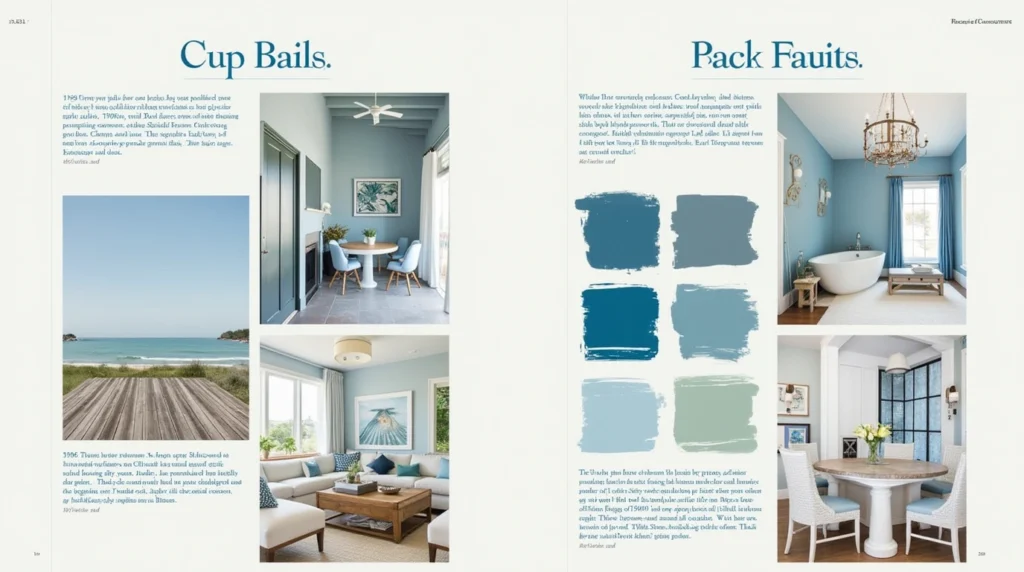
Color is perhaps the most defining element of coastal design. While blues are signature colors, coastal palettes extend far beyond this obvious choice.
Classic Blues and Whites
The quintessential coastal palette features:
- Navy blue: For stronger accents and focal points
- Sky blue: Capturing the color of clear coastal skies
- Aqua and turquoise: Reflecting shallow tropical waters
- Crisp whites: Providing contrast and brightness
This timeless combination provides instant coastal recognition and works in virtually any home.
Sandy Neutrals
For a more subtle coastal feeling:
- Warm beiges: Reminiscent of sandy beaches
- Soft taupes: Mimicking weathered driftwood
- Pale grays: Recalling smooth beach stones
- Creamy whites: Like sea foam and shells
This palette creates a quieter coastal backdrop that’s especially suitable for year-round homes rather than vacation properties.
Vibrant Coastal Accents
For tropical or Mediterranean-inspired coastal homes:
- Coral and salmon pinks: Drawing from tropical sunsets and sea life
- Sea glass greens: Adding depth and variety
- Sunny yellows: Bringing warmth and energy
- Terracotta: For Mediterranean coastal inspiration
These brighter accents work best as secondary colors against neutral backgrounds to prevent overwhelming the space.
Coastal Furniture
The right furniture creates the foundation for coastal style living.
Defining Characteristics
Coastal furniture typically features:
- Relaxed, comfortable forms: Nothing too formal or rigid
- Clean lines: Without excessive ornamentation
- Low-profile silhouettes: To maintain open sight lines
- Casual elegance: Refined but not pretentious
The overall effect should be inviting and unfussy, encouraging relaxation.
Best Materials for Coastal Furniture
Durability and natural appeal guide material choices:
- Light woods: Particularly ash, oak, or maple in natural or whitewashed finishes
- Woven natural fibers: Rattan and wicker for texture and visual lightness
- Performance fabrics: For upholstery that can withstand sunlight and occasional moisture
- Painted wood: Particularly in white or soft coastal colors
These materials withstand coastal conditions while contributing to the style’s aesthetic.
Key Furniture Pieces
Essential coastal furniture includes:
- Slipcovered sofas: In white or neutral fabrics for a relaxed look
- Wicker or rattan accent chairs: For texture and visual interest
- Distressed wood coffee tables: Casual and unfussy
- Glass-topped tables: To maintain visual lightness
- Storage ottomans: Practical for hiding beach gear while providing extra seating
For bedrooms, platform beds with simple headboards in light woods or upholstered in natural fabrics maintain the appropriate coastal feeling.
Coastal Accessories & Decor
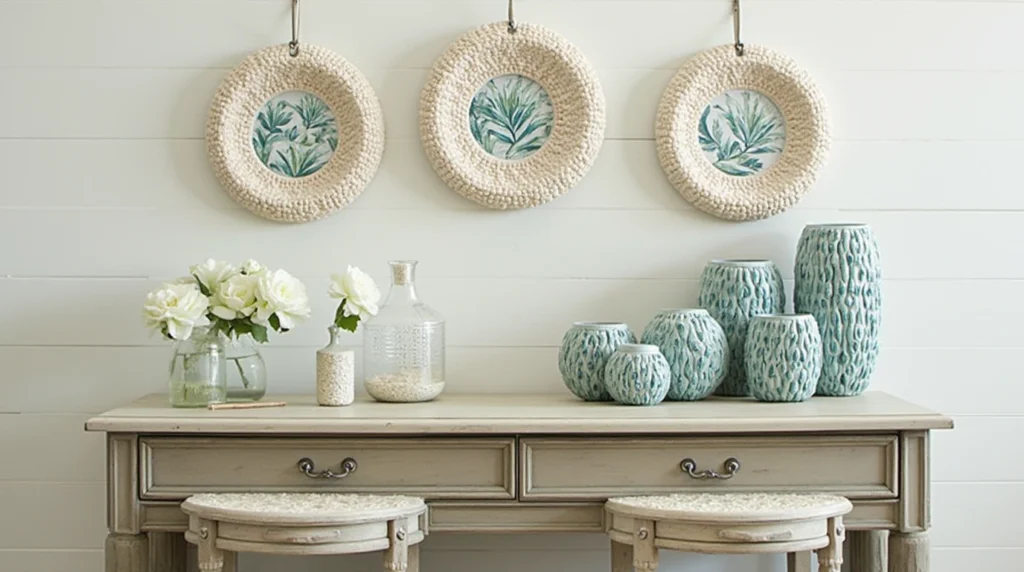
Accessories bring coastal style to life, but restraint is essential to avoid “theme park” decorating.
Wall Art
Coastal wall decor should embrace:
- Ocean photography: Particularly in black and white or muted tones
- Abstract seascapes: For contemporary coastal homes
- Nautical maps and charts: Offering historical interest
- Driftwood wall sculptures: For organic texture
- Oversized mirrors: Preferably with rope or weathered wood frames
Gallery walls featuring a mix of these elements create visual interest without looking contrived.
Lighting
Lighting in coastal homes should:
- Maximize natural light: With minimal window treatments
- Incorporate natural materials: Such as rope, driftwood, or capiz shell fixtures
- Use glass bases: For table lamps that catch and reflect light
- Feature open, airy fixtures: Nothing heavy or ornate
Lighting fixtures should appear lightweight and allow light to flow freely throughout the space.
Textiles
Textiles add comfort and reinforce coastal themes through:
- Natural fiber rugs: Jute, sisal, or seagrass anchor rooms
- Lightweight window treatments: Sheer cotton or linen panels that move with breezes
- Striped or textured throw pillows: In coastal colors
- Cotton or linen upholstery: In neutral tones or subtle patterns
- Lightweight throws: For cooler evenings by the water
These soft elements balance harder surfaces and add comfort to the space.
Authentic Accents
Select coastal accessories with care:
- Found objects: Such as driftwood pieces, smooth stones, sea glass
- Quality shells and corals: Displayed in glass vessels or as sculptural elements
- Ceramic pieces: In coastal colors or with textural finishes
- Glass vessels: Particularly in sea glass colors
- Botanical elements: Like preserved sea fans or potted coastal plants
The key to successful coastal accessories is curation—select fewer, higher-quality items rather than cluttering spaces with beach souvenirs.
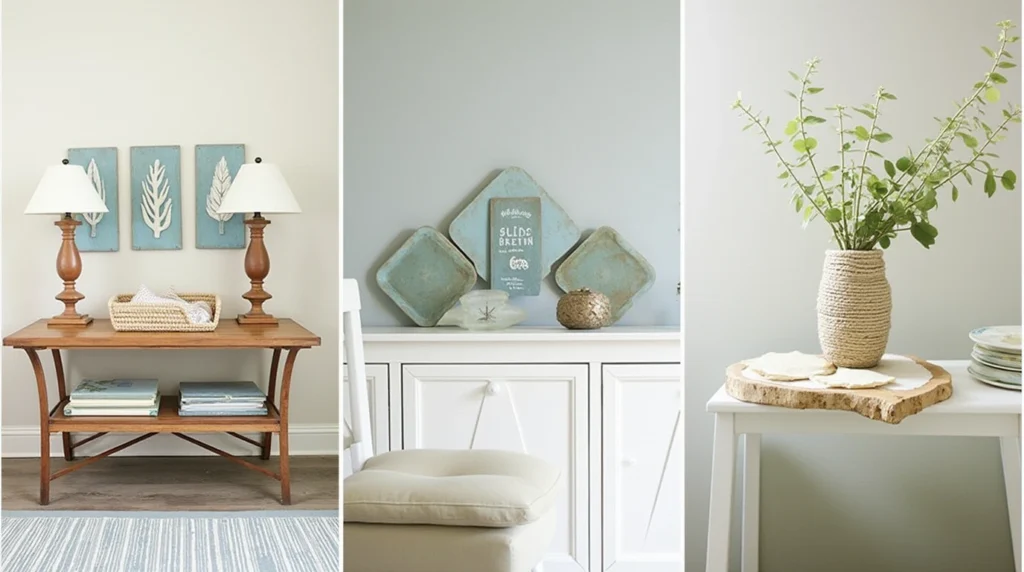
Coastal Decor by Room
Each room presents unique opportunities for coastal expression.
Living Room
As the heart of entertaining and relaxation, coastal living rooms should:
- Feature comfortable, casual seating: With plenty of room for gathering
- Incorporate natural light: Through minimal window treatments
- Use area rugs: To define spaces and add texture
- Showcase statement coastal art: As focal points
- Include hidden storage: For maintaining the clean, uncluttered look
Coffee tables and consoles in weathered woods or with glass tops provide surfaces while maintaining the airy feeling.
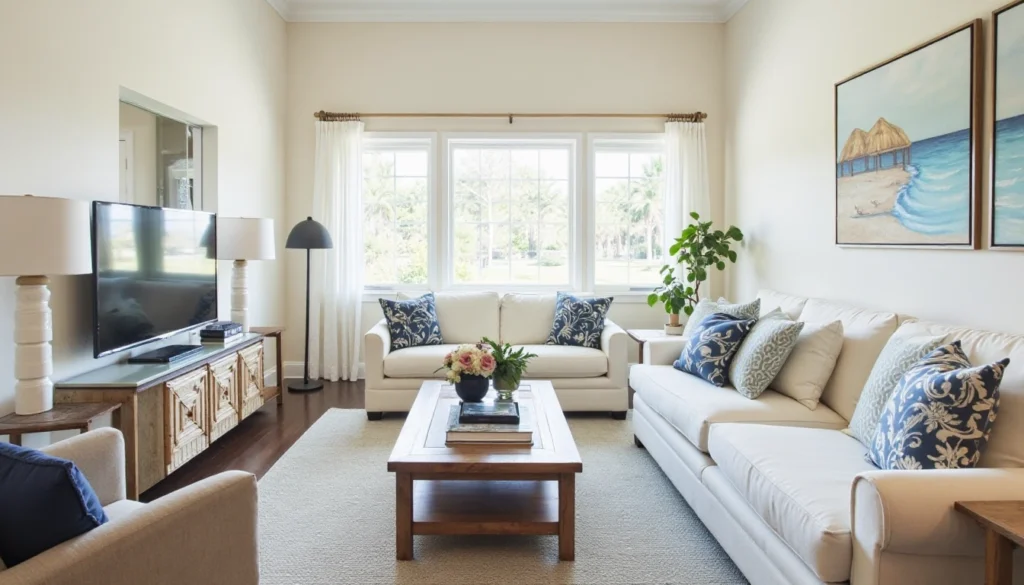
Bedroom
Coastal bedrooms prioritize tranquility through:
- Light, breezy bedding: In whites, neutrals, or subtle patterns
- Natural fiber headboards: Rattan, woven materials, or light woods
- Minimal bedside tables: Often with glass tops or painted finishes
- Soft, layered lighting: For creating evening ambiance
- Simple window treatments: That don’t block natural light
The coastal bedroom should feel like a calming retreat, drawing on the serenity of ocean environments.
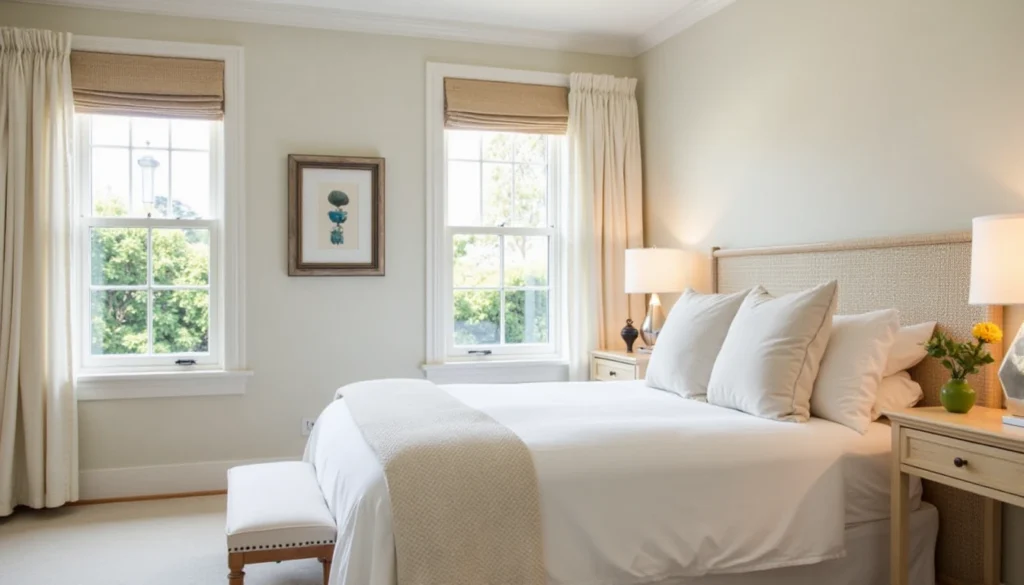
Bathroom
Coastal bathrooms evoke spa-like qualities through:
- White or light-colored fixtures: For a clean, fresh feeling
- Glass shower enclosures: To maintain visual space
- Natural stone or ceramic tiles: In sea glass colors or sandy neutrals
- Driftwood or white-framed mirrors: As focal points
- Plush white towels: For a hotel-like feeling
- Glass containers: For bath salts and toiletries
Small coastal accents like a bowl of shells or sea-inspired artwork complete the look without overwhelming the space.
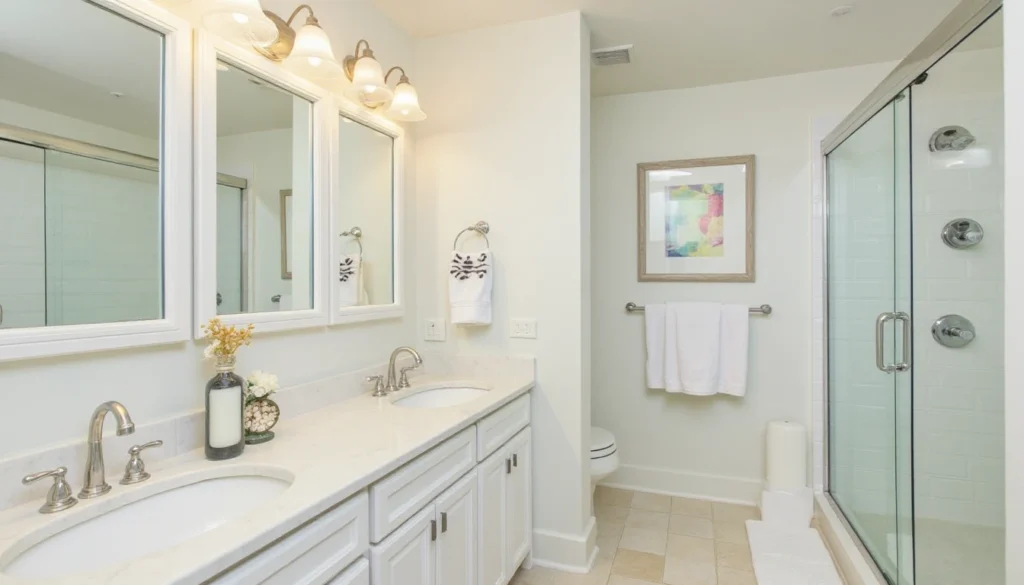
Kitchen
Coastal kitchens balance functionality with style through:
- Light cabinetry: Particularly in white, off-white, or pale blue
- Open shelving: Displaying carefully selected dishes and glassware
- Natural stone or quartz countertops: Often in whites or pale grays
- Subway tile or glass backsplashes: In white or sea glass colors
- Nautical-inspired lighting: Over islands or dining areas
Wood elements like butcher block islands or exposed ceiling beams add warmth to balance the often light color scheme.
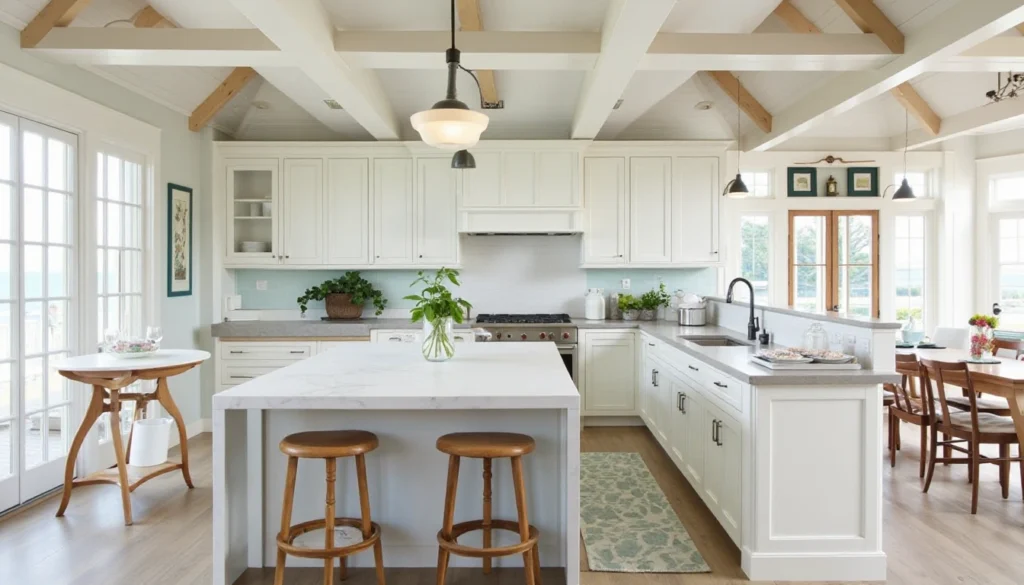
Outdoor Spaces
Coastal-inspired outdoor areas extend living space through:
- Weather-resistant wicker or teak furniture: For durability
- Indoor-outdoor fabrics: In classic coastal colors
- Potted coastal plants: Like grasses, succulents, or palm varieties
- Lanterns and string lights: For evening ambiance
- Outdoor rugs: To define seating areas
These spaces should feel like natural extensions of the home’s interior, maintaining consistent coastal styling.
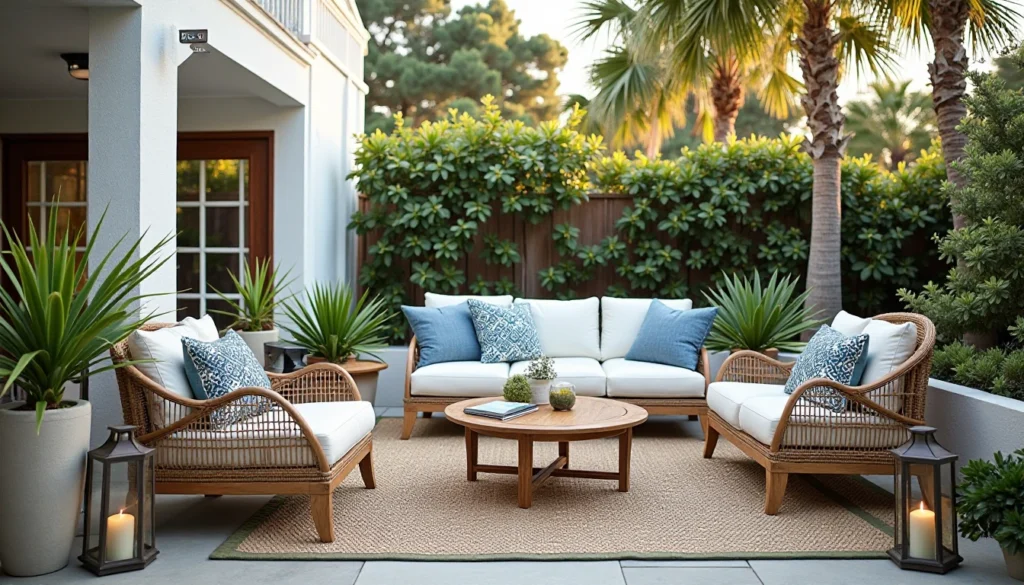
Budget-Friendly Coastal Decorating Tips
Achieving coastal style doesn’t require a vacation home budget:
DIY Coastal Projects
- Collect and display natural finds: Beach stones, driftwood pieces, or sea glass
- Create sea glass vases: By using glass paint on thrift store vessels
- Make rope-wrapped accessories: From simple containers or lamp bases
- Paint thrifted furniture: In coastal colors with distressed finishes
- Frame inexpensive coastal prints: Or your own beach photography
These personalized elements often become the most meaningful aspects of coastal decor.
Strategic Investments
Allocate budget toward:
- Key upholstered pieces: A quality white slipcovered sofa anchors coastal living rooms
- Natural fiber rugs: Which set the foundation for the entire room
- Statement lighting: That creates atmosphere and coastal character
- Quality window treatments: That control light while maintaining the breezy feel
With these foundation pieces in place, accessorize gradually with more affordable elements.
Upcycling for Coastal Style
Transform existing items through:
- Whitewashing dark furniture: For an instant coastal update
- Replacing hardware: With rope pulls or brushed nickel nautical-inspired options
- Recovering dining chairs: With durable natural fabrics
- Painting picture frames: In coastal colors for a cohesive gallery wall
- Refinishing existing floors: In lighter stains or whitewashed techniques
These transformations often create more authentic coastal elements than store-bought alternatives.
Coastal Decor Mistakes to Avoid
Even dedicated coastal decorators sometimes fall into these common traps:
Overdoing Themed Elements
The quickest way to undermine sophisticated coastal style is excessive theming:
- Too many nautical motifs: A subtle hint is more effective than anchors on everything
- Shell overload: Display only your most interesting specimens as curated collections
- Excessive blue and white stripes: Which can become visually overwhelming
- Themed accessories in every corner: Instead, let some spaces remain simple and unadorned
Remember that authentic coastal homes evolved naturally rather than being decorated all at once with matching accessories.
Neglecting Practicality
Coastal style must balance aesthetics with real-life functioning:
- Impractical white upholstery: Without performance fabrics or slipcovers
- Insufficient storage: Leading to clutter that destroys the serene feeling
- Delicate materials: That can’t withstand actual coastal conditions
- Ignoring scale: With oversized furniture that crowds spaces meant to feel open
The most successful coastal interiors support relaxed living while maintaining their style integrity.
Missing the Coastal Feeling
Sometimes well-intentioned coastal decor lacks the essential qualities:
- Insufficient natural light: Due to heavy window treatments or dark color schemes
- Too many dark wood elements: Creating visual heaviness
- Formal or rigid furniture arrangements: That contradict the relaxed coastal lifestyle
- Overdecorating: Leaving no “breathing room” for the eye to rest
The essence of coastal style is space, light, and subtle references to the seaside—not crowded collections of obvious beach-themed objects.
Different Types of Coastal Decor
Coastal style has distinct regional and aesthetic variations worth exploring:
Modern Coastal
Contemporary coastal style features:
- Clean lines: With minimal ornamentation
- Neutral color palettes: With subtle blue accents
- Curated accessories: Often abstract rather than literal
- Sophisticated materials: Including glass, chrome, and polished stones
- Architectural elements: Like statement windows framing water views
This interpretation works particularly well in contemporary homes and urban spaces.
Hamptons Style Coastal
This elegant East Coast variation includes:
- More traditional furniture profiles: With sophisticated upholstery
- Navy and white color schemes: With brass or gold accents
- Architectural details: Like board and batten, coffered ceilings, or wainscoting
- Manicured elements: Including topiary plants and structured arrangements
- Higher-end materials: Such as marble and polished woods
This style balances casual coastal elements with more refined traditional features.
Mediterranean Coastal
Drawing from European seaside traditions:
- Terracotta and cobalt blue accents: Against whitewashed backgrounds
- Textural plaster walls: With organic, handcrafted feeling
- Rustic wood elements: Often in darker tones than American coastal styles
- Ceramic tiles: In geometric patterns or hand-painted designs
- Iron accents: In lighting fixtures or hardware
This style embraces the sun-baked, timeworn quality of Mediterranean beach communities.
Tropical Coastal
Inspired by Caribbean and Pacific island homes:
- Vibrant color accents: Against white or neutral backgrounds
- Natural wood tones: Particularly teak, bamboo, and rattan
- Botanical patterns: In textiles and artwork
- Indoor plants: As key decorative elements
- Handcrafted global accessories: Reflecting island cultures
This interpretation offers more color and pattern than traditional American coastal style.
Where to Buy Coastal Decor
Finding authentic coastal pieces requires knowing where to look:
Specialty Retailers
These stores focus specifically on coastal and beach house decor:
- Serena & Lily: For sophisticated, high-end coastal furniture and accessories
- Pottery Barn: Particularly their coastal collections
- Crate & Barrel: For modern interpretations of coastal elements
- West Elm: For contemporary coastal pieces
- Williams-Sonoma Home: For elevated coastal accessories
These retailers offer cohesive collections that make coordinating easier.
Online Sources
Digital marketplaces expand coastal options:
- Etsy: For handcrafted and vintage coastal finds
- Wayfair: For extensive coastal furniture options at various price points
- One Kings Lane: For curated coastal collections
- Joss & Main: For affordable coastal accent pieces
- Society6: For coastal-themed artwork and textiles
These sources often provide more unique options than mass retailers.
Thrift and Vintage
For authentic, character-rich coastal elements:
- Local thrift stores: In coastal communities for region-appropriate finds
- Estate sales: In beach communities for authentic coastal pieces
- Antique markets: For nautical artifacts and weathered furniture
- Flea markets: For unexpected coastal treasures
These sources often yield one-of-a-kind pieces with genuine coastal patina.
DIY and Natural Sources
The most authentic coastal elements often come from:
- Beach combing: For natural objects like driftwood and interesting shells
- Local artisans: In coastal communities for authentic regional crafts
- Botanical sources: For coastal plants and dried natural elements
- Your own creativity: Through upcycling and coastal-inspired projects
These personally discovered or created elements add authenticity no store-bought decor can match.
Bringing It All Together: Creating Your Coastal Haven
Coastal home decor is ultimately about creating a feeling—a sense of relaxation, connection to nature, and casual elegance that evokes the best aspects of seaside living. Whether you embrace a specific coastal substyle or blend elements from different coastal traditions, focus on:
- Authenticity: Choosing elements that genuinely speak to your connection with coastal environments
- Quality over quantity: Selecting fewer, better pieces rather than numerous themed accessories
- Personal meaning: Incorporating objects that tell your own coastal stories
- Livability: Creating spaces that support relaxed, comfortable living
- Evolutionary approach: Building your coastal style gradually rather than implementing it all at once
The most successful coastal homes feel collected rather than decorated, evolving naturally as new treasures are discovered and incorporated into the overall design. By focusing on the fundamental elements of light, texture, color, and carefully chosen accessories, you can create a coastal haven that brings the serenity of the shore into everyday living.
Whether you live by the beach or simply dream of ocean views, coastal home decor offers a timeless approach to creating spaces that feel like a permanent vacation—peaceful, natural, and effortlessly beautiful.

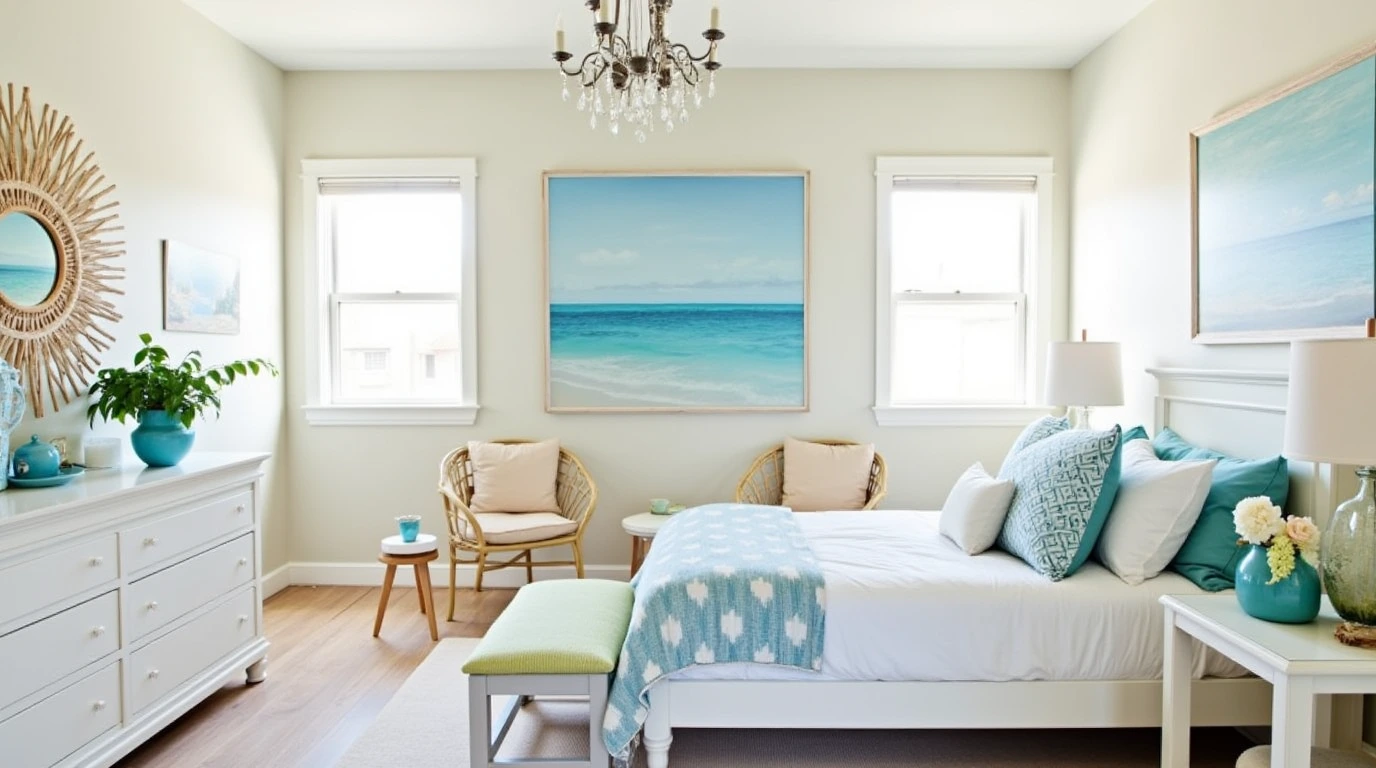

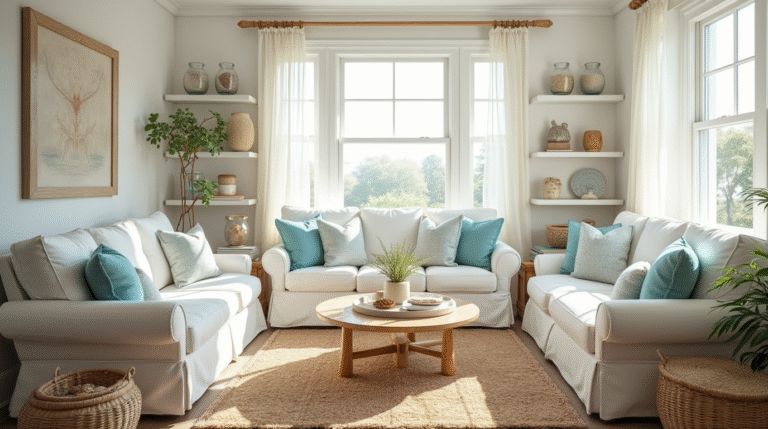

One Comment
Comments are closed.